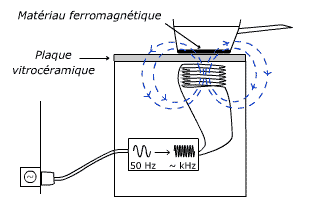How does it work ?
There are two intervening mechanisms :
- Induction as such : a coil linked to a source of high frequency alternating current is placed under the stove top. The variation of current in the coil generates, around the coil, a variable magnetic field. M.Faraday’s experiments in the 19th century showed that an electric current is created in conducting material when it is subjected to a variable magnetic field. On the basis of this principle, when a saucepan is placed on the ceramic hob above the coil, an electric current is created in the metal. The saucepan will heat up better if made of a material with high electric resistance. With induced currents, the resistance of an object will be higher if the material is ferromagnetic (which explains the use of these materials in cooking ustensils intended for induction stove tops): the heat produced by the passage of current will be higher. So, this leads us to speak about the Joule effect…
- the Joule effect : when a current passes through a resistance, this resistance heats up (see, for instance, the filament of a light bulb). It “resists” to the passage of the current. The same is true when a current is created in a piece of metal by induction. This generates losses by the Joule effect, therefore creates heat. Thus, induction stove tops directly heat up the metal of the saucepan, which transfers heat to foods. While functioning, the vitroceramic hob will stay quite cool since, unlike a classical electric stove top, it is not heated up directly.
The nature of the object placed on the stove top determines its proper functioning. This requires that the saucepan be made of a material that sufficiently heats up whenever induced currents circulate.
3. I have an apparatus allowing me to perform electromagnetic field measurements. The scale of the values displayed ranges from 0.1 to – 199.9 Gauss. How can we make the conversion in µT? Is there a concordance between Tesla and mA/m?
A Gauss to µT conversion is done as follows :
1 Gauss = 0,1 mT (milliTesla)
Converted into Tesla, the scale of your apparatus ranges from 0,01 mT (or 10 µT) to 19,99 mT (or 19 990 µT).
This scale is not accurately adapted to measurements in household environments where magnetic field intensities are often in the region of µT.
As for your second question, the International System of Units recommends using the following units :
- the magnetic field intensity (noted H) is expressed in Ampere/meter (A/m);
- the magnetic induction, also named magnetic flux density (noted B), is measured in Tesla (T).
The ratio between B and H is the magnetic permeability (noted µ), which is expressed in Henry-meter (H/m):
B = µ . H
The magnetic permeability of a material is the capability of this material to channel magnetic induction, in other words, to concentrate magnetic flux lines and thus to increase the value of magnetic induction. This means that this value depends on the material in which it is produced. In the air, B (Tesla) can be calculated from H (A/m):
B = 1,26 x 10-6 H
This formula means that a H field of 1 A/m in the air will be associated to a B field of 1,26 microTesla (µT).
4. We have just started building a wooden frame house. Several electricians have warned us against the risk of electromagnetic fields in this kind of houses, where “wood fibers could tend to propagate these fields much more, particularly electrical fields, than a traditional house”. They have already measured values above 60 V/m inside these houses, with notably harmful effects on sleep. These electricians sell systems with shielded cables, more expensive than traditional systems… What is your opinion about this question? Is it a fraud or is there a real need to install bioruptors and shielded cables in a wooden frame house?
Indeed, wooden houses, having in general neither slabs in reinforced concrete nor steel bars in the walls, do not shield the electric field linked to external sources (high voltage powerlines, electrical transformers) or internal (electrical wiring, electrical apparatus…).
The effect of external electric field could be easily counterbalanced by placing a very thin and metallic shell (e.g. aluminium paper) either adjacent to insulation or against the roof. A lot of dirt-cheap possibilities certainly exist.
However, it is important to realize that the effect of electric fields on health has not been scientifically proved. The standard currently advocates to limit the field to 10 kV/m, i.e. 10.000 V/m. The value of the electric field inside your house, even if it was under a 400 kV line, would never exceed this value. With the aluminium paper mentioned above, there would be no electric field inside your residence (except, of course, near internal sources).
Protection against magnetic fields from external sources is far more difficult (and it is not linked to the kind of house) and would require the use of a ferromagnetic material which is far more expensive (for further information on the characteristics of these materials, see ACE team.
Concerning fields generated by your own electrical wiring, there are shielded cables (VMVB like – with ferrite) on the market that could limit them. Bioruptors could also be an additional precaution, since the wiring of some parts of the electrical circuit is subjected then to low voltage when no electrical devices are connected.
If you are concerned about this problem, we advise you to specifically protect the bedrooms where you spend 1/3 of the day. For that purpose, you can use VMVB cables and bioruptors for the corresponding circuits, and also, why not, for the circuits linked to rooms with taps (bathroom, kitchen .).
However, please note that we face far more problems linked to bad electrical wirings than problems with external electric or magnetic fields. Therefore, we warmly advise you to have the electrical installation made or modified by an accredited company. We particularly insist on the rooms with water (bathroom as a priority) with the installation of appropriate differentials. You must also check that the grounding respects the current standards for the equipotentiality of metallic structures (radiators, pipes…).
5. My home is located below (around 8 metres) a 20,000V line and around twenty metres from two 63,000V lines. Do the fields from these two lines add together?
No, the fields are not simply added together arithmetically. An electric or magnetic field is a vector field, i.e. it has a direction. The direction varies continuously as the source varies sinusoidally (three-phase alternating current supply).
In general, a three-phase source can be considered as generating a rotating field at a given place (see Electric and magnetic fields for further information).
As the current through a line generally varies with the square of the voltage, to a first approximation we can consider that the field generated by the 63kV line is around 10 times higher than the one generated by the 20kV line. The fact of being 20m away from it instead of 8m partially offsets this value. In a first approximation, the field can be estimated from the 63kV line only. You will find these values in the page entitled Health risk issues (see Exposure Analysis – 70kV line). Only a measurement will corroborate this value.
The addition of the fields is thus a vector addition, which can lead to a decrease or an increase. But the sum will always be less than the arithmetic sum. It depends on the configuration of the lines, and of course the current through these lines.



